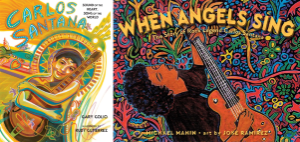2018 School Spending Survey Report
Review of Carlos Santana: Sound of the Heart, Song of the World; and When Angels Sing: The Story of Rock Legend Carlos Santana
Carlos Santana:
Sound of the Heart, Song of the World
by Gary Golio; illus.
 Carlos Santana:
Carlos Santana:Sound of the Heart, Song of the World
by Gary Golio; illus. by Rudy Gutierrez
Primary Ottaviano/Holt 40 pp.
9/18 978-1-62779-512-8 $18.99
When Angels Sing:
The Story of Rock Legend Carlos Santana
by Michael Mahin; illus. by Jose Ramirez
Primary Atheneum 48 pp. 9/18 978-1-5344-0413-7 $17.99
e-book ed. 978-1-5344-0414-4 $10.99
Carlos Santana’s 1971 rendition of Tito Puente’s classic Latin jazz anthem “Oye Como Va” still elicits instant recognition, perhaps because Santana’s signature guitar communicates the essence of Latino sabor. Two new picture-book biographies center Santana’s formative years and the experiences that shaped his musical corazón. In Carlos Santana, Golio presents a chronological account of Santana’s boyhood growing up in the birthplace of mariachi music — Jalisco, Mexico — where his father teaches him to read music and play violin, and later buys him his first guitar. The acute pain of separation felt “when Papá is gone — sometimes for months — earning money” balances against Gutierrez’s tender and realistic rendering of Santana’s mother, who moves her family to Tijuana to seek a better life. Brown faces predominate in the swirling, psychedelic, sixties-inspired acrylic illustrations, illuminating the centrality of family despite Santana’s at-times contentious relationship with his father. In When Angels Sing, Mahin’s staccato second-person text (“One day, you went to Aquatic Park. Los congas rumbled into your chest. There was magic in their beat. A breath. A breeze. A feeling”) lends immediacy to his account of Santana’s youth. Mahin relates the boy’s experiences of migration (first within Mexico and then to San Francisco), racial discrimination, and poverty in a manner both accessible and deep. He shows how Santana’s brother’s activism and determination during California’s 1960s farmworkers’ struggle inspires Santana to keep playing guitar and never give up (“If they can, I can”). Ramirez’s full-bleed Mexican-folk-art–influenced acrylic and enamel marker illustrations expertly capture mood and propel the narrative forward, subtly incorporating year stamps on many spreads to mark the passage of time. While both books cover similar events in Santana’s boyhood, Mahin’s buoyant and lyrical storytelling allows the reader closer proximity to the musician’s world. Author’s notes and bibliographies in each book contextualize Santana’s place in American popular culture; Golio’s book also appends a glossary.
From the November/December 2018 issue of The Horn Book Magazine.

RECOMMENDED
ALREADY A SUBSCRIBER? LOG IN
We are currently offering this content for free. Sign up now to activate your personal profile, where you can save articles for future viewing.







Add Comment :-
Be the first reader to comment.
Comment Policy:
Comment should not be empty !!!